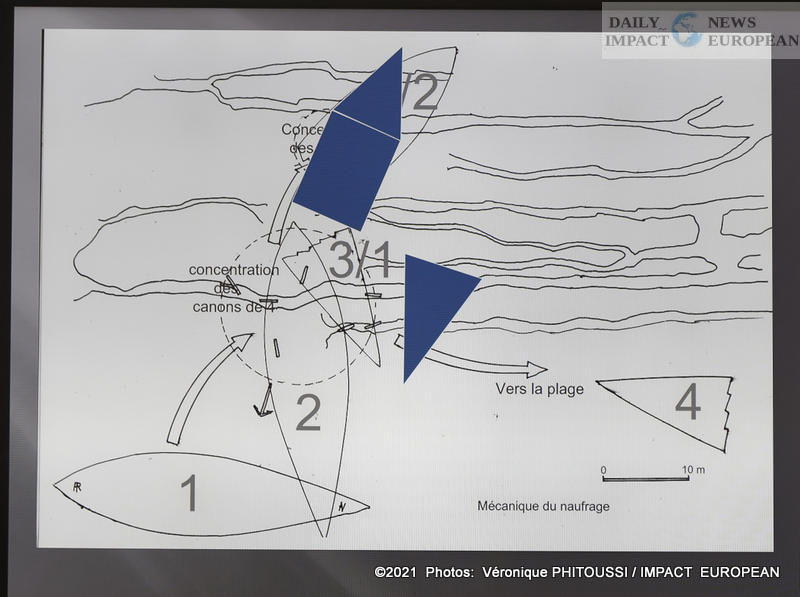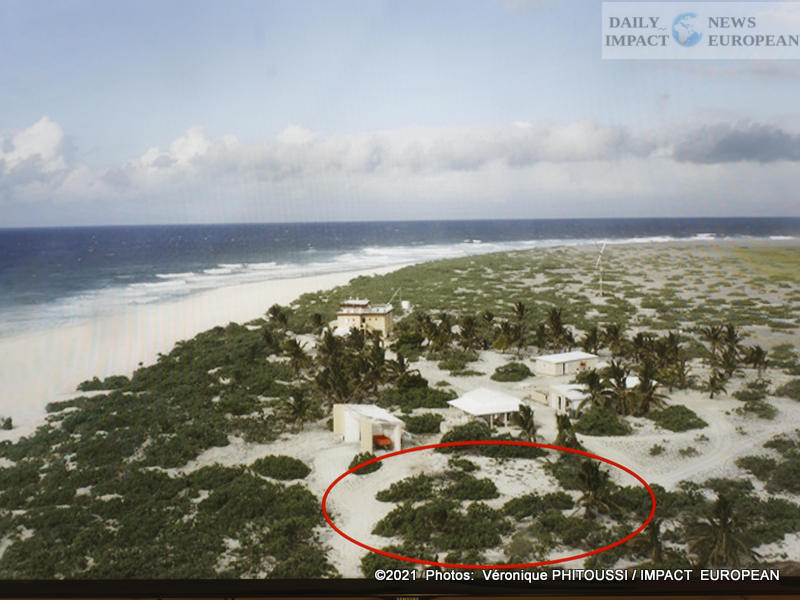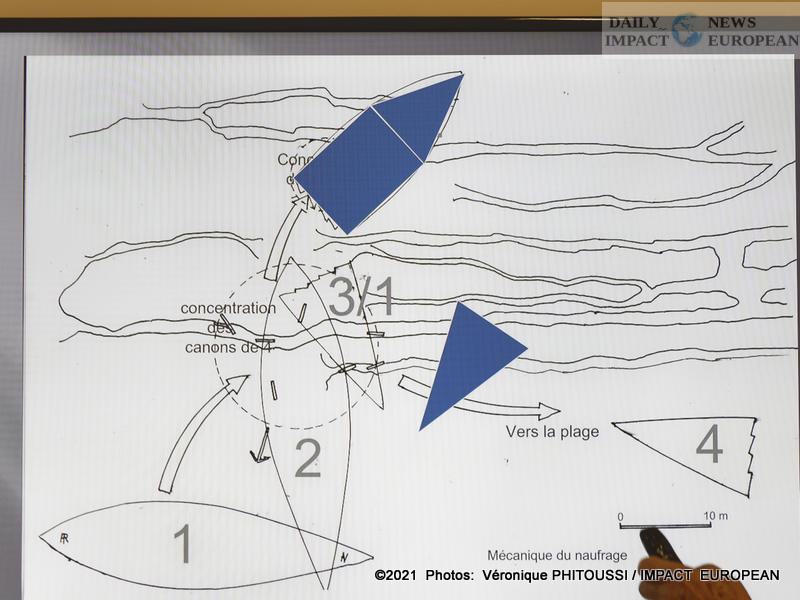The Exhibition is in partnership with Inrap, GRAN and the Musée de l’Ephèbe and Underwater Archeology of the city of Agde.
« L’Utile », a ship of the French East India Company, had left Bayonne on November 17, 1760, and ran aground on July 31, 1761 on the Isle of Sable, now called the Isle of Tromelin. « L’Utile » was not a slave ship and it actually deposited the slaves.
« L’Utile » transported 160 Malagasy slaves bought in fraud, intended to be sold in the island of France (current Mauritius).
The crew returned to Madagascar in a makeshift boat, leaving 80 slaves on the island, with the promise to come and look for them soon. On November 29, 1776, fifteen years later, the ensign, future knight, Tromelin, commanding the corvette La Dauphine saved the eight surviving slaves, including seven women and an eight-month-old child.
The island of Tromelin is a deserted islet of 1 km² off the coast of Madagascar. The island is completely isolated, it is not a lagoon but a reef invaded by storm winds. The island is a coral coast therefore extremely dangerous. The southern part is completely submerged by the sea so the slaves were forced to go to the top, the highest point of the island is 8m. Their habitat was on the high point of the island.
Photo 14 represents the southern part of the island, photo 27 shows the northern tip, photo 8 represents the weather station based on the trajectory of the cyclones, they served as a warning for Madagascar, warning them of impending cyclones.
In the midst of war with the English, the company bought a boat. At the time, there were a lot of privateers, making it difficult to find sailors. The boat will sail and will bypass the Cape of Good Hope and Mauritius. The crew will buy food with a formal ban on bringing back slaves.
Despite this ban the commander will buy 160 slaves and decides to embark and disembark them a little to the east, thinking of bringing them back gradually in small batches to sell them.
Unfortunately for him, he arrives at night and fails. Twenty sailors from the crew drowned, along with half of the slaves. They were drowned, stuck in the boat shattered by the storm.
Some slaves did try to leave the island to reach Madagascar, but they never succeeded.
Later, the English Company was redeemed and they waited several years before sending troops to retrieve the slaves. The ship sinks and a sailor ends up with the slaves on the island. The surviving slaves (around 80) await help and will be rescued 15 years later, including a woman and her baby.
Underwater excavations took place and were necessary because they had little information about the 15 years that slaves spent on the Island.
The project took a long time to come to fruition because of the cyclones and some people tried to dissuade him from leading this expedition.
The excavations revealed that the Castaways had built buildings to protect themselves from the wind. Their site was built with anchors, cannonballs and cannons and the wood of the boat was used as a reserve for the fire;
On the map drawn by the pilots of the Utility (boat), we can see the place where they had built their makeshift boat.
The excavation was very difficult under the breaking waves, the archaeologists realized that the underwater fauna were not very fearful, they had never seen humans so no fear on their part (photo 2).
The beach goes down to 4000m deep, it was a concern to calculate the surf, the sea was channeling, and the members had to wait for the other wave to return to the beach. So complicated and dangerous underwater excavation conditions.
In a photo, you can see an oven,
On the old map, there are no bricks from the ship’s oven. The kiln was found when they were digging where there were tiles and bricks. The turtles, while making their nests, dug up the debris.
Archaeologists completed 4 missions in 2006,2008, 2010 and 2013.
The weather station was built in prefabricated form but was destroyed by cyclones and rebuilt afterwards. During their excavations, archaeologists crossed the island right through.
In yellow, we can see the walls of the Madagascan castaways,
In 2013, the island demarcated the land use zone with abandoned or lost objects or meat bones or turtles. An area made of a mixture of sand and ash is visible and above the debris of the first weather station.
Archaeologists were certain that the slaves had suffered flooding caused by the cyclones. The center of the island is made up of constructions made with natural cement made from coral dust, sand and sun, 1m high.
In Madagascar, it was forbidden to build stone settlements, they were made of wood; They built their houses like tombs. The walls were 1.50m by 2m high. They had a social structure. The Castaways were easy to adapt and a certain social cohesion was created.
The photo with the areas in yellow shows over a period of 15 years, 3 different states of construction.
- The buildings were built and destroyed,
- The castaways built buildings around a central courtyard and this central courtyard represented solidarity,
- Afterwards, they built another building 8m long by 3m wide and 2m high.
Their decision was joint and life was organized there.
Photo 28 shows the designer during the expedition,
They found water at 3m50, they ate birds (terns, water birds),
Photo 11 shows that there was a large tern colony on the island,
Photo 19 shows the different bones recovered, therefore, the archaeologists knew what the castaways ate, grilled birds, they removed the grilled flesh with a sharp object (marks on the bones), on the other hand, the green turtles offered no more flesh to eat.
For example, in November 2013, 700 turtles came to lay their eggs (1m50), so it was easy to find food. There are also about fifteen fish in very small numbers that could be eaten.
The turtles have a thin layer of keratin on their backs, traces of marks on the backs of the turtles were found as the castaways pulled the turtles on their backs to empty them of their flesh, other marks were found inside of the hull showing that the castaways were chopping the flesh (photo 12).
Photo 32 shows crockery recovered from the boat by the slaves. They found lead containers, they soldered but the archaeologists do not know how the castaways did it, as it is very hard to work with the lead (recovered from the boat); The women managed to keep the fire (flint, hammer, axis…). We can see a copper object repaired 7 times with small tabs, this denotes a desire to survive and continue life even in difficult conditions and isolated from everyone.
Photo 1 shows dishes made by the slaves (pikes and spoons, bracelet, unraveling points). The unraveling spikes have designs. The slaves really created, installed a way of life.
Photo 25 shows a ladle collected by the slaves.
A testimony from an English officer informs that there was no cemetery or body. On the other hand, the discovery of two bodies of young people of 20 years deceased (of death neither violent nor accidental) were found lying down. Recently, the DNA of the teeth has shown that they are Comorians.
It is in the heart of the 18th century that we dive to discover the trade established by the Compagnie des Indes and the slave trade of the time. At the time, when the facts were discovered in metropolitan France, the story of the « Forgotten of Tromelin » « was denounced by Condorcet and the abolitionists, on the eve of the French Revolution.
This story was discovered and revealed thanks to the joint research of GRAN and Inrap. They were able to reconstruct this extraordinary story, understand the circumstances of the tragedy and obtain information concerning the daily life of the slaves, their living conditions on the island, by crossing the remains found on the site during the excavations and the analysis of the documents.
We would like to thank the Mission du Patrimoine Littoral for having organized this conference presented by the archaeologist Monsieur at the Agde Tourist Office in parallel with the exhibition « The Castaways of the Island of Thomelin » which will be held on June 18. 2021 to September 27, 2021.
The designer, Sylvain Savoia was invited on a month-long expedition to Tromelin by Max Guérout, a former naval officer and underwater archaeologist to bring the history of the forgotten people of Tromelin to life.
Many creations have emerged following this discovery of the Castaways of Thomelin. Irène Frein wrote a novel in 2009, a film was shown at the Museum on June 2, they took 3 years to do it; A choreography was created from this story. The Overseas Minister has placed a plaque on the Ile de Thomelin. It is a really important place in the Indian Ocean.
Dear reader,
You have read and enjoyed our article and we thank you for it. In order for us to continue our work of informing, investigating and investigating, we need your help. Impact European is different from most French and International media:
- We are an independent media, we do not belong to a large group or to large business leaders, therefore the subjects we deal with and the way we do it are free from prejudices or special interests , the analyzes that we publish are carried out without fear of possible pressure from those in power.
- Our journalists and contributors work collectively, above individual motivations, with the objective of seeking common sense, in search of truth in the general interest.
- We have chosen to remain free for everyone, so that everyone has the possibility of being able to access free and quality information regardless of each person’s financial resources.
That’s why we are asking for your support. More and more of you are reading us and giving us marks of confidence, this support is precious, it allows us to establish our legitimacy as a free and independent media and the more you read us the more we will have an impact on the media noise. ambient.
So if you want to help us, it’s now. You have the power to participate in the development of Impact European and above all to ensure that we continue our information mission. Every contribution, big or small, is important to us, it allows us to invest for the long term. The whole team thanks you.
Support Impact European from € 1>





































More Stories
Jenny d’Ormond, the mastery of 3D painting
Élysée: tripartite meeting between Trump, Zelensky and Macron
GREEN SANTA CLAUS ARE BACK